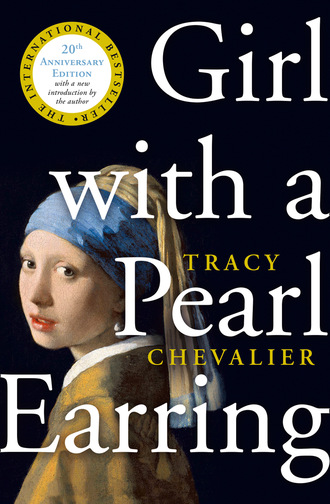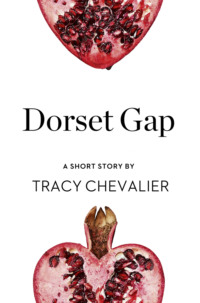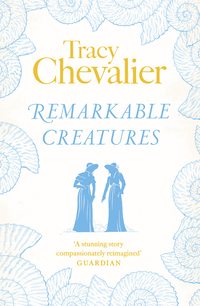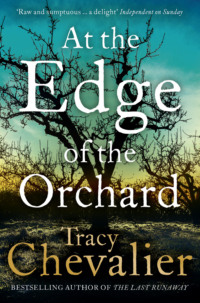
Полная версия
Girl With a Pearl Earring


Copyright
The Borough Press
An imprint of HarperCollinsPublishers
1 London Bridge Street
London SE1 9GF
www.harpercollins.co.uk
First published in Great Britain by HarperCollinsPublishers 1999
Copyright © Tracy Chevalier 1999
Cover design by Holly Macdonald © HarperCollinsPublishers Ltd 2019
Cover image Girl with a Pearl Earring, c. 1665-6 (oil on canvas), Vermeer, Jan (Johannes) (1632-75) / Mauritshuis, The Hague, The Netherlands / Bridgeman Images
Tracy Chevalier asserts the moral right to be identified as the author of this work.
A catalogue record for this book is available from the British Library.
This novel is entirely a work of fiction. The names, characters and incidents portrayed in it are the work of the author’s imagination. Any resemblance to actual persons, living or dead, events or localities is entirely coincidental.
All rights reserved under International and Pan-American Copyright Conventions. By payment of the required fees, you have been granted the non-exclusive, non-transferable right to access and read the text of this e-book on-screen. No part of this text may be reproduced, transmitted, down-loaded, decompiled, reverse engineered, or stored in or introduced into any information storage and retrieval system, in any form or by any means, whether electronic or mechanical, now known or hereinafter invented, without the express written permission of HarperCollins.
Source ISBN: 9780007232161
Ebook Edition © December 2018 ISBN: 9780007324361
Version: 2018-12-10
Praise for Girl with a Pearl Earring:
‘Timeless, delicate and as exquisitely measured as one of Vermeer’s paintings, this novel entered my life when I was 16, and plunged me, probably forever, into the world of Golden Age Holland. Tense yet perfectly paced and filled with the beauty of life’s colours, Tracy Chevalier’s story of the personal costs behind art’s public genius is a masterpiece in its own right. I will hold this novel close for the rest of my life’
JESSIE BURTON
‘A portrait of radiance … Tracy Chevalier brings the real artist Vermeer and a fictional muse to life in a jewel of a novel’
TIME
‘Chevalier doesn’t put a foot wrong in this triumphant work … It is a beautifully written tale that mirrors the elegance of the painting that inspired it’
WALL STREET JOURNAL
‘It has a slow, magical current of its own that picks you up and carries you stealthily along … a beautiful story, lovingly told by a very talented writer’
DAILY MAIL
‘Chevalier’s writing skill and her knowledge of 17th-century Delft are such that she creates a world reminiscent of a Vermeer interior: suspended in a particular moment, it transcends its time and place’
NEW YORKER
‘This is a wonderful novel, mysterious, steeped in atmosphere. It is deeply revealing about the process of painting … a truly magical experience’
GUARDIAN
‘This is a novel which deserves, and I am sure will win, a prize – or two’
THE TIMES
‘Life in 17th-century Delft is evoked with a sharp eye for historical detail and the descriptions of Vermeer at work are superbly drawn. A sensuous and vividly crafted work of fiction from a highly-talented young novelist’
MAIL ON SUNDAY
Dedication
For my father
Table of Contents
Cover
Title Page
Copyright
Praise
Dedication
Introduction
Reflections on Girl with a Pearl Earring
1664
1665
1666
1676
Acknowledgements
About the Author
Also by Tracy Chevalier
About the Publisher
Introduction
Time is so elastic that twenty years can feel like a lifetime or a week. To me it seems only a year or two since Girl with a Pearl Earring was quietly published in the dog-days of August 1999, with little fanfare and a couple of respectable reviews.
Five million copies later, forty-three languages later (not counting Persian: illegally published, then banned by the Iranian government, recently unbanned – but still illegal!), a film with Scarlett Johansson and Colin Firth later, this book is still running. It has legs, as they say. And I am still a little stunned by its success.
My relationship with Vermeer’s painting Girl with a Pearl Earring extends back far more than twenty years, however. I first discovered it existed in Autumn 1981 when I visited my sister in Boston. Walking into her apartment, I made a beeline for the poster of an unfamiliar painting that hung on her wall. The light, the colours, the girl’s piercing gaze: I was smitten. So much so that the next day I bought a poster of it for myself. It has accompanied me everywhere I’ve lived since. I even took it to London and back on a semester abroad during my university years. That same poster – now tattered and faded – still hangs in my study, and I look at it every day. Despite my love affair with the Girl, though, I only saw the painting in the flesh for the first time at a seminal Vermeer retrospective at the Mauritshuis museum in The Hague in Spring 1996.
I have always been mesmerized by its beauty. The bright blue and yellow of the Girl’s antique headdress, the way light and shadow sculpt her face, the liquid pools of her eyes, the perfectly placed dab of white pearl in the dark shadow of her neck: these details are all not so much about the beauty of this particular girl herself, but choices Vermeer made in how to portray her. In fact, this is not a portrait of a specific person, but a tronie, a Dutch term for an idealized head of a ‘type’ of person, in this case a young woman. It is meant to be a universal image.
And yet: that gaze is specific. She is looking at us as if she knows us.
That last sentence contains a mistake that took me sixteen years to correct. One morning in November 1997 I was lying in bed in my London flat, looking at the poster, sixteen years after first discovering the Girl in Boston, and thought, ‘I wonder what Vermeer did to make her look at him like that.’ It was like a switch flipped. I had always thought she was looking at me, at us. But of course she wasn’t ever looking at us – she was looking at Vermeer when he painted her. That unreadable gaze – that yearning, guarded look – is at him.
Suddenly the painting became not about a specific girl, or even an idealized girl, but about a relationship. And what was that relationship? We don’t know. No one knows who the model was, and we know little about Vermeer either.
Right away I knew I was onto something. It’s rare to pinpoint specific moments in our lives that are true forks in the road, but that morning was one of them for me. A switch kind of flipped in my writing life too, and everything changed. Within three days I had made up the story of Griet, the servant who cleans Vermeer’s studio and catches his eye.
I researched and wrote Girl with a Pearl Earring in a dream-like bubble – quickly over nine months (I was pregnant, with a built-in biological deadline), as an unknown writer with no expectations from readers or publishers or myself. When I wrote the book I tried hard to be respectful of Vermeer, of the process, of the painting. I left a lot of space – literal (it’s short) and figurative – for the reader to consider and form her own opinions. In the worst-case scenario, people read Girl with a Pearl Earring and turn to the cover to study the painting. In the best case, afterwards they study other paintings more carefully too. My favourite contact with readers is when they tell me they look at art differently now.
Why has the book been so popular that we’re celebrating its 20th anniversary? Partly it’s the strength of the painting. But the novel also has a rare quality that I am not sure I will ever be able to replicate in another book. The style reflects and supports the subject. When I was first working on it I thought: You’re writing about Vermeer, so write it the way he paints – spare, focussed, stripped down to the essentials. Two clichés absolutely worked for me: Less Is More, and Form Follows Function. Many novels tell stories well, or create a unique style, but few successfully combine the two so that they support each other and become more than the sum of their parts.
Since that Mauritshuis show in 1996 and – perhaps – since the book’s success, Vermeer has become a Big Deal. Probably he would have anyway, and I am simply the luckiest writer ever to have been in the right place at the right time and able to ride the wave of his popularity. Even given that there are only thirty-six Vermeer paintings in existence, he is now one of the most exhibited Old Masters. Over the last twenty years I have seen Vermeer shows in London, New York, Madrid, Rome, Cambridge, Dublin. Most only displayed two or three Vermeers, and bulked out the offering with work by his contemporaries, with themes focussing on his hometown of Delft, or women, or genre paintings, or music – whatever link they could make that justifies showing the Vermeers.
Inevitably, to me at least, Vermeer’s paintings always leapt out from the others. His work has an ethereal quality that is hard to pinpoint. His colours are intense, his focus tight, his subjects seem to be in worlds of their own that we only get a peek at without being invited in. Viewers spend a long time in front of his work, much longer than with others. They are trying to figure out the magic. But that’s the thing about magic – it only works when you don’t know the trick.
If anything, the painting itself is even more popular than Vermeer himself. The image of the Girl is everywhere, on umbrellas, suitcases, jigsaw puzzles, bookmarks, water bottles. There is a Miffy doll dressed as the Girl, and a rubber duck of her that I float in my bath. Banksy has painted her on a Bristol wall with an existing security alarm in place of her earring. A friend’s daughter dressed up as her for Hallowe’en. My cousin Pierre had a boutique vineyard for a while in California and named his best bottle ‘One Pearl’, with the painting on the label. I have on occasion worn socks where the Girl peeks out from my ankles.
Social media is awash with images of her. There are over 25,000 Instagram posts with the hashtag #girlwithapearlearring featuring drawings and paintings copying the painting, embroidery of the image, cats and dogs inserted in place of her face, and lots and lots of people dressed up like her... Back before social media became the place to communicate, readers used to write to me sending photos of themselves or their daughter or their friend, dressed up as the Girl. Doesn’t my daughter look just like her? they said. No one does, however. Despite the universality of her appearance – her hair and eye colour unknown, her face turned so we can’t see the shape of her nose – the Girl is decidedly herself.
Do I feel guilty about this overexposure? Sometimes. The novel may well have played a part in that. But no matter how dispiriting it is to see an image of Girl with a Pearl Earring on an ashtray, somehow the painting manages to rise above such exposure and maintain its fundamental mystery. What is the Girl feeling as she looks at the painter? I have written a novel about that look, and talked about it for twenty years, and I still don’t know. As long as the mystery remains – and it always will, I think – we will be enchanted by the painting and everything associated with it.
Tracy Chevalier
February 2019
Reflections on Girl with a Pearl Earring
by Rose Tremain
I’ve been trying to analyse what makes this novel so successful – a veritable work of art.
I feel that two things are key: the pace and the form.
Much is made, in the book, of the fact that Vermeer painted slowly – too slowly for the whims of his family, who waited so impatiently for works to be finished and to be sold for good money. It seems to me that Tracy has made a beautiful virtue out of this slowness in the shaping of her novel. Things unfold in a calm, unhurried and uncluttered way. The narrative has almost a shy coyness about itself, willing to give us only so much at any one time to lure the reader deeper and deeper into the story. It moves at Vermeer’s pace. But, just as we are confident that the artist is embarked on works of great beauty and stillness, so, here, we see the author quietly bringing to life a delicate human drama.
How Tracy controls the form is complex. It relates, once again to Vermeer himself and the gentle way in which the innocent maid, Griet, begins to understand his technique, which is unhurried and arduous. He moves people, objects and furniture around until he has found the combination that feels right to him. And Tracy does the same, giving us ever-changing alignments of the circumstances and the people who are going to shape Griet’s destiny. When Vermeer begins to paint, he does surprising things, laying on dull backgrounds before beginning to sketch in the figures. He explains to Griet that the colour white is almost never ‘pure’, but brought to purity, and brought to its crucial role in a painting (eventually the earring itself) by the presence of other tones within it.
And this is how Tracy shapes her narrative – by small, unexpected increments, often defined by colour (the red of the butcher’s blood under Pieter’s nails, the cloudy white of the laundry, the Delft blue of Griet’s father’s tiles, the flaming tones of Cornelia’s hair) laying them in sparingly and – most crucial of all – never anticipating for us too neatly what role they are going to play.
Tracy always researches her books very thoroughly. To write about quilt-making she makes quilts. To write about fossils, she gathers and studies them, thus giving great authenticity to the work. But in Girl with a Pearl Earring we experience a lot more than a feeling of a writer doing meticulous homework; we are led deep inside the strange, closed world of the artist and the innocent girl who, for a brief moment, moved him to a love he could only express through a picture. We are as captive to that world as Griet is captive to her master. This is one of those rare novels where all the decisions made by the author appear inevitable and right. And millions of readers agreed. They were perfectly at home in this book. They felt they were part of a timeless painting.
RT. 2018

Конец ознакомительного фрагмента.
Текст предоставлен ООО «ЛитРес».
Прочитайте эту книгу целиком, купив полную легальную версию на ЛитРес.
Безопасно оплатить книгу можно банковской картой Visa, MasterCard, Maestro, со счета мобильного телефона, с платежного терминала, в салоне МТС или Связной, через PayPal, WebMoney, Яндекс.Деньги, QIWI Кошелек, бонусными картами или другим удобным Вам способом.










